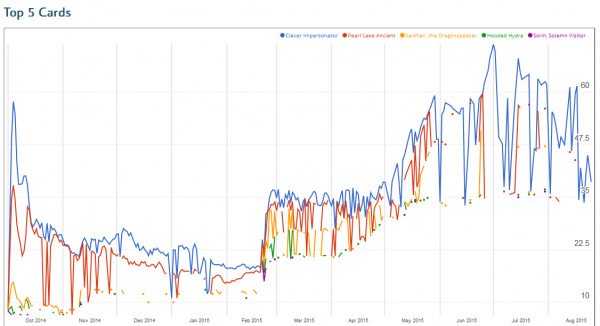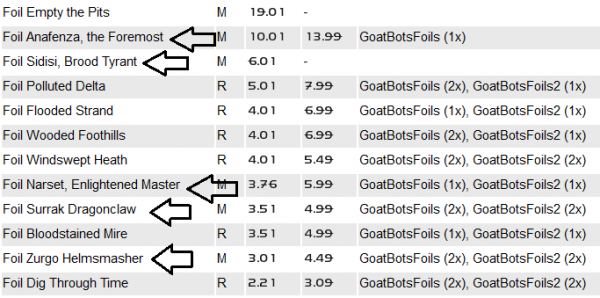Are you a Quiet Speculation member?
If not, now is a perfect time to join up! Our powerful tools, breaking-news analysis, and exclusive Discord channel will make sure you stay up to date and ahead of the curve.
Greetings Insiders, and welcome to the final installment of my discussion about foil mythic rares on MTGO. If you missed Part 1 or Part 2, be sure to check them out before continuing. Those articles covered the basic phenomena behind the wild price movements of foil mythics. Today we'll look at the investment strategy that can exploit these phenomena--one that is profitable enough and consistent enough to basically fund your entire MTGO experience.
Before that though, we have one more dimension of the price movements to discuss: the special case of seeded packs.
Foil Mythic Rares from Magic Origins & Khans of Tarkir
For the particular cases where there are prereleases with seeded packs, as was the case with Magic Origins, there’s one more piece of information to incorporate. Some of the foil mythic rares from ORI are more common than the others. If you look at the list, it’s easy to spot that the seeded packs held the foil versions of the flip planewalkers. As a result, they are relatively common when compared to the other 10 mythic rares of ORI. All things being equal they are cheaper than the rest of the foil mythic rares.
In the case of a card like Kytheon, Hero of Akros, no one is really looking to use him in Standard at the moment, so most of the value, of either version, is tied up in being part of the redemption bottleneck. When mythic rares are expensive, the foil version will track the expensive non-foil version due to being a perfect substitute. But when mythic rares are cheap, like Kytheon is right now, the foil versions end up just being an expensive substitute so their prices diverge.
On the other end of the spectrum, both versions of Jace, Vryn's Prodigy are the most expensive card in their respective sets. In this case, the foil version has an approximate price floor that is based off of the price of the regular version. Foil Jace is a perfect substitute for regular Jace, so if regular Jace is 20+ tix, it makes sense that the foil version will be 20+ tix. The utility from Jace, Vryn's Prodigy as a game piece is the dominant factor in the value of both versions, while the dominant factor in the value of the cheaper flip planewalkers is as a component to a complete set--i.e. the value comes from being the bottleneck to redemption. Foil Nissa, Vastwood Seer is also priced as a substitute for regular Nissa, with both versions priced at 15.99 tix at the moment.
Kelly Reid has put together a new tool which can help highlight how foil mythic prices change over time on MTGO. Going back to KTK, here's a screen shot of the top 5 foil mythic rares, as tracked by Cardhoarder. Note the data set is a little spotty as the foil mythic market can be very thin, especially when a set is no longer being drafted. But we can see that the five most expensive cards have been in the 30-65 tix range since May 2015, and that they are Clever Impersonator, Pearl Lake Ancient, Sarkhan, the Dragonspeaker, the aforementioned Hooded Hydra and Sorin, Solemn Visitor.

The Foil Mythic Strategy
With all the above theory and observations in mind, a definitive strategy becomes clear.
1) Buy foil mythic rares, even the junk ones, and hold onto them until after a set is no longer being drafted.
2) Do not buy any foil mythic rare that shows up in a seeded pack.
For players, this is a particularly amazing strategy. What it means, in practical terms, is that a player who can pay the upfront cost of a playset of each of the foil mythic rares will actually accrue value on their purchase over time. Players can confidently buy the foil mythic rares knowing that they are making a good investment and that they will be able to play with all the new mythic rares immediately. This is a huge win from a player’s perspective and will make playing on MTGO much more affordable over the longer term.
In practical terms this strategy is currently working for the non-seeded pack ORI foil mythic rares. When purchased for 12 tix or less, most of the foil mythic rares from ORI are already above this price level. As ORI continues to be drafted, the dynamics described above are predictably playing out for this set, and the average price of a foil mythic rare is drifting higher. The trick with ORI was to avoid the foil versions of the flip planeswalkers as they are more common than the other mythic rares so they will not tend to accrue value in the same way.
When Battle for Zendikar is released in the Fall, the same strategy can be employed by players and speculators, but with a lower price in mind. The seeded packs are not returning for BFZ prereleases, so there will be no skewed distribution of foil mythic rares. As of today, 10 tix is a reasonable price target for speculators to start buying any foil mythic rare from BFZ. On the other hand, players should just go ahead and buy a playset of each foil mythic rare during the tail end of release events, regardless of the price, having full confidence that the digital cards they are buying will accrue value over time.
After they’ve played with the foil versions for a few months, players will be able to trade them in for the regular versions that have steadily dropped in price. Players will get the chance to play with the new cards from BFZ right way (albeit at a higher up-front cost), and then down the road they will be able to sell them back into the market for a good price. The proceeds will cover buying the regular versions and can go towards covering the cost of the next set's foil mythic rares.
It’s important to stress that buying a complete basket of the foil mythic rares is necessary for this strategy to work. Although the overall price trend is predictable, particular cards can see dramatically different results . If someone can explain why Rakdos, Lord of Riots from RTR goes for 90+ tix and not Niv-Mizzet, Dracogenius, I am all ears. Buying a complete basket ensures that gains will average out and players won’t miss out on the one card that sees an extraordinary price.
For both players and speculators, the conclusion generated by applying the theory of redemption to foil cards is a startling one and everyone should heed this result. If followed, the strategy detailed above will mean that players will spend less to play online as they transition from gradually losing value on their cards to gradually gaining value.
Actionables for Battle for Zendikar
1. Buy any BFZ foil mythic rare available in the 8 to 12 tix range.
2. At or near the conclusion of release events, buy playsets of any foil mythic rares not already purchased, at any price.
3. Enjoy your digital objects!
4. Sell all your foil mythic rares in March 2016 and buy regular versions.
5. Profit!








I really enjoyed the read, great series!
I’m curious if you think the expeditions will have any effect on this theory. Let’s assume that this will be one of the most opened sets ever and the paper mythic and rare prices will tank. Will this make redemption less desirable and thus make the MTGO mythics follow a different price pattern?
This article series looks at foil prices in particular, and paper foil prices are much more stable than the regular versions. I don’t expect the pattern to be any different, and if regular mythic and rare prices do tank, this will actually accelerate the flow of value to foil mythic rares because the regular rares will be so cheap.
Little comment : during FRF prerelease (first evening) i opened a foil Monastery Mentor; I sold it on the spot for over 30 tic. The next morning it was down to 15. Now it could be sold for 25.
So do sell the opened mythics on the first prereleasenight,i’d say, after that period it seems Matt got it figured out.
Thanks for the articles.
Yes, prices can get very wild in the first week of pre releases and release events. Players should be looking to buy in the later half of events when availability will be higher and prices more stable.
Hey Matt! Great article! Very insightful. I was just wondering is the prices you recommend we buy foil mythics from BFZ apply currently with Origins, or if its too late to adquire them. Thank you so much for your work!
Great article Matt. Nice work. One of the factors I felt you touched on without stating explicitly is that the bad mythics tend to rise a lot more than the good ones. I suspect this may be for the same reason that random $2 casual paper cards turn into $10 cards given enough time: ie The Closet Effect. The Closet Effect refers to a lack of media coverage and player chatter surrounding a mediocre card leading to most copies being hidden away in collections, closets and under beds, forgotten and ignored. In these cases demand eventually outstrips supply and prices rise. With random KTK foils mythics like Hooded Hydra and Pearl Lake Ancient, my guess is that there are plenty of those cards lying around in online collections, but most players aren’t aware they’re worth anything, and as such, the bots have trouble getting a hold of them, leading to the spikes once supply peaks pass. Thoughts?